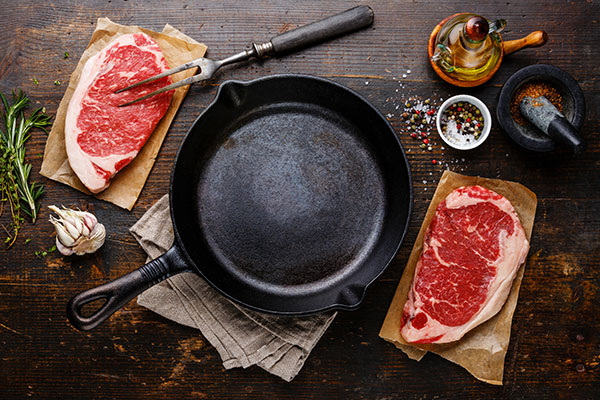If the weather outside is frightful, it may be time to move your cooking indoors. But just because a temperature drop has you rushing inside, that doesn’t mean you need to give up on your grill favorites. Translating outdoor staples to indoor cooking requires the right tools and a little creativity—though I don’t recommend attempting to smoke meats indoors, it requires far too much effort to be worthwhile. Below I’m sharing the tips, tricks, and tools I use to cook great steaks, burgers, and more when the weather forces me inside.
To Grill Pan or Not to Grill Pan
Grill pans are the subject of some controversy among grillers. To their credit, they produce very pretty grill marks and offer a healthier option since the pan’s ridges keep the meat from sitting in its own grease while cooking. That said, I rarely use a grill pan because I prefer an overall sear for my meats. Most of the flavor comes from the sear, so I’ll sacrifice grill marks for a better tasting meal any day.
If you like the idea of a healthier option though, there are a wide variety of grill pans available. For the option that requires the least oil and offers the easiest clean-up, buy a non-stick grill pan. To ensure excellent heat retention, crisp grill marks, and basically indestructible construction, grab a cast iron model.
What to Cook
While you can cook just about anything indoors, that doesn’t mean it’s going to taste as good. Items that benefit from “low and slow” cooking (like ribs and pulled pork) could be prepared in a broiler or an oven, but you’ll lose the smoky flavor. If you want to cook something that requires little time and attention indoors, a crockpot is your best bet.
Recipes that cook hot and fast are a much better choice for indoor cooking. If you’re looking to fire up a steak or some burgers in the winter months, it’s time to invest in cast iron. These heavy-duty pans help create a delicious crust on your meat as it cooks and I prefer cooking my burgers on cast iron for that reason.
Steaks also benefit from the superior heat retention of a cast iron pan. I use the reverse sear method, starting in a 225 degree oven, and then finish my steaks in a screaming hot cast iron pan with butter and rosemary. Be sure to use a dependable meat thermometer (like the Thermoworks Signals or the ThermoWorks Smoke X4 RF) while your steaks are in the oven or you’ll risk over- or undercooking them. You’ll miss some of the flavor from the grill, but with this technique you’ll still enjoy a perfectly cooked interior with a tasty sear on the outside.
Techniques to Try
If you’ve never attempted sous vide cooking, winter is the perfect time to try. Invest in a sous vide machine and experiment with cooking meat at a controlled temperature in a water bath, using a pan sear to finish. It won’t be quite the same taste as if it came fresh off the grill, but it will produce a flavorful cut of meat every time. For a dish that is sure to impress, try my sous-vide veal chops and finish with a pan sear instead of cooking on coals.
Most grilling techniques can be (somewhat) adapted to indoor methods if you get creative. If you try any of the above techniques (or if you have a favorite indoor grilling hack of your own), tag me on Instagram to let me know how you’re keeping the grilling fun going all winter long!


